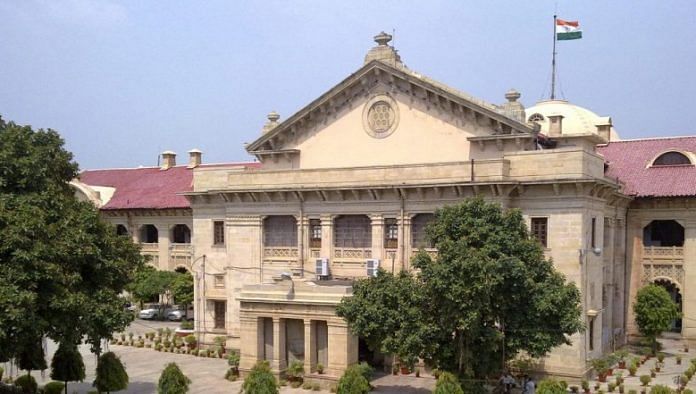Justice Shukla is ‘guilty’ of misconduct in the same case that CJI Misra was under the scanner for. Involve the opposition or not, govt will be taking a risk.
New Delhi: Twenty days after Chief Justice of India Dipak Misra recommended the removal of Allahabad High Court’s Justice Shri Narayan Shukla, the government is still discussing when and how to kick-start the process.
The CJI had written to President Ram Nath Kovind after Shukla was found guilty of misconduct by an internal probe into a medical college admission scam. Shukla was initially asked by the CJI to step down – to resign or retire. When he refused, the CJI asked the Chief Justice of the Allahabad High Court to not allocate any judicial work to Shukla.
The only way to remove a judge is to begin the onerous task of impeachment by Parliament. Since impeachment motions have always been initiated only by the opposition in the past, it puts the government in a tricky spot.
Sources told ThePrint that the government is unlikely to bring up the issue in the ongoing Budget Session of Parliament.
Options before the government
According to sources with knowledge of developments, one of the options before the government is to get MPs of the Bharatiya Janata Party to initiate the motion, and then pass it using its brute majority in the Lok Sabha.
The other option is to build a consensus among opposition parties and bring a motion, since the government does not want to be seen as interfering with the independence of the judiciary.
“Historically, the opposition has initiated the motion. But this is no conundrum. The government has to follow due process and simply put the question to Parliament as early as possible,” said Bikramjit De, professor of legal and constitutional history at the National University of Juridical Sciences, Kolkata.
“Once the question is out in Parliament, MPs can vote as they choose,” De said.
However, he did add a word of caution — that the government also “cannot ask its party MPs to vote one way or the other if it wants to be seen as non-partisan”.
Risk of involving the opposition
Involving the opposition is risky, as the charges against Justice Shukla relate to the Lucknow medical college admission case, which had put CJI Misra himself under the scanner.
A three-judge bench led by the CJI had heard the case involving Lucknow’s Prasad Education Trust. Shukla had heard the same case in the high court, and is now indicted for “acting in a manner unbecoming of a judge” for his handling of the case.
The government is worried that discussing the impeachment of Shukla could embarrass the CJI, whose tenure ends in October this year.
Last month, CPI(M) general secretary Sitaram Yechury had said that opposition parties were trying to build a consensus on moving an impeachment motion against CJI Misra.
Procedure of impeachment
While the CJI and the collegium hold sway in the appointment of judges, their removal does not involve the judiciary. As per Article 124(4) of the Constitution and the Judges (Inquiry) Act, 1968, only the President can order the removal of a judge with the aid of Parliament.
The only grounds for impeachment are “proved misbehaviour and incapacity”.
To kick-start the process, a motion for impeachment must be raised in either house of Parliament. The motion must be raised by at least 100 MPs in the Lok Sabha and at least 50 MPs in the Rajya Sabha to be accepted by the respective chairperson of the house.
If the motion is accepted, a three-member committee will be set up to investigate the charges against the judge. Based on the findings of the committee, both houses then need to pass an “address to the President”, seeking the removal of the judge. This address again needs the support of two-thirds of the members present in each house, and the attendance must be greater than 50 per cent of the strength of the house.
Finally, the President can issue directives to remove the judge.
History of impeachment motions
– Last year, two successive bids to bring an impeachment motion against Justice Nagarjuna Reddy of the High Court of Andhra Pradesh and Telangana failed.
– In 2015, 58 members of the Rajya Sabha sought impeachment proceedings against Justice S.K. Gangele of the Madhya Pradesh High Court after charges of sexual harassment were made against him. But a Rajya Sabha-constituted probe panel gave him a clean chit in December last year.
– In 2015, a group of 58 Rajya Sabha MPs moved an impeachment notice against Justice J.B. Pardiwala of the Gujarat High Court for his “objectionable remarks on the issue of reservation”. In a few hours, the judge withdrew his controversial comments from the judgment.
– Justice Soumitra Sen of the Calcutta High Court resigned in 2011, just before the Lok Sabha was set to take up an impeachment motion against him. The Rajya Sabha had passed a motion for impeaching Sen, making him the first judge against whom Parliament successfully initiated an impeachment motion. Even though then-CJI K.G. Balakrishnan had written to the President to remove Sen, the Congress-led UPA government did not react. Yechury and 56 other MPs had moved the motion.




Was wondering what happened to Shukla! Seems like CJI wants to pinch the baby and rock the cradle….